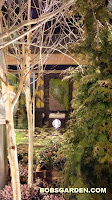In a continued post on the 2009 Seattle Garden Show this post
is focused on outdoor water features. I've grouped them in
types to show just a few of the many styles of water
features there are. After seeing these beautiful
displays it really makes me want to
incorporate one into the garden.
the infinity edge feel. It's a pond less style so it's easy to maintain.
Love the repetition of shapes of tiles and water feature.
And the lighting inside --- amazing!
Love the repetition of shapes of tiles and water feature.
And the lighting inside --- amazing!
 Another pond less style but with basalt spires. This style
Another pond less style but with basalt spires. This stylehas been around for a while but still is a great look. For those that
are not familiar with basalt spire water features
the spires are drilled in the center to allow the
water to cascade out.
 Another reflecting pond with a Southeast Asian influence. The repeated pots in
Another reflecting pond with a Southeast Asian influence. The repeated pots inthe center were a nice touch and anchor this display.
 The lighting from below on the cube form of the contemporary
The lighting from below on the cube form of the contemporary water feature was very effective. Water came from the center of
the square and cascaded over all four edges.
 This water feature incorporated natural and industrial elements.
This water feature incorporated natural and industrial elements.The water was cascading out of galvanized flashing
which contrasted nicely with all the mosses,
boulders, logs, and foliage.
As you can see there were many styles and something for everyone.
I hope it inspires you to find a place in you garden for one.
BOTANICAL WORDS:
trichocaulon - meaning with a hairy stem
plants with this word - Hypericum trichocaulon




























